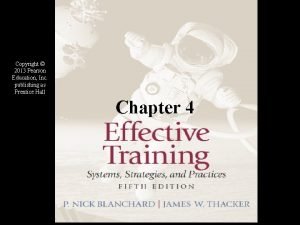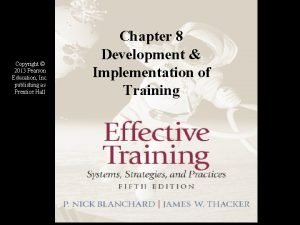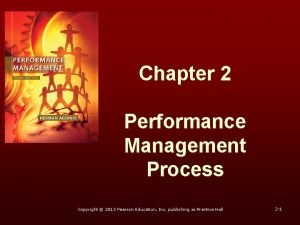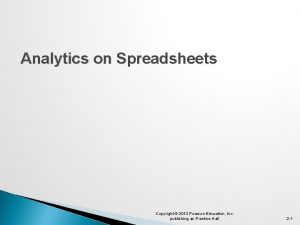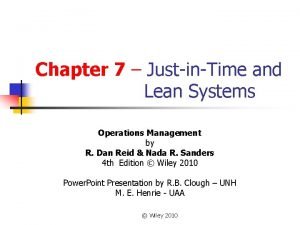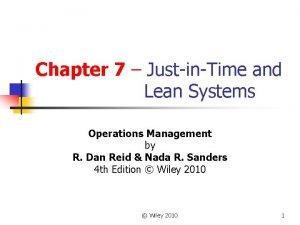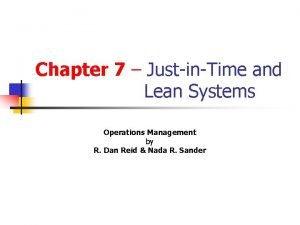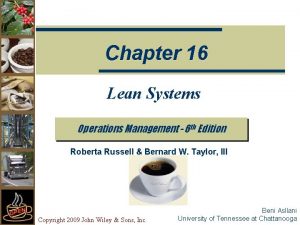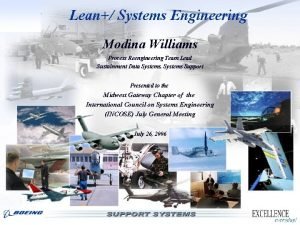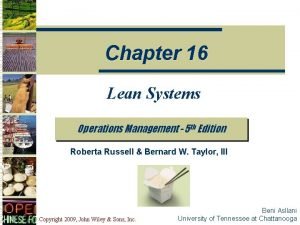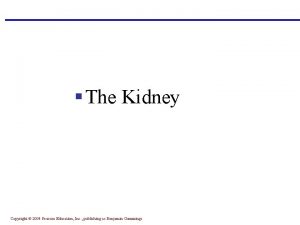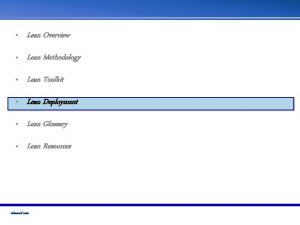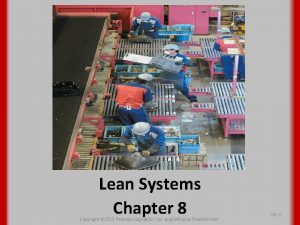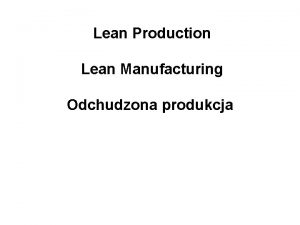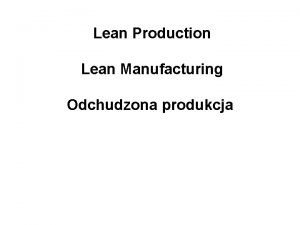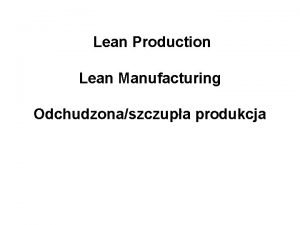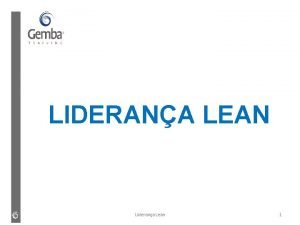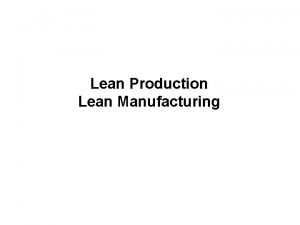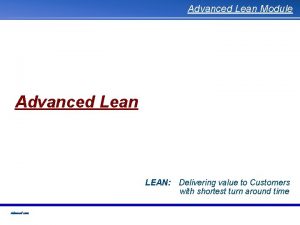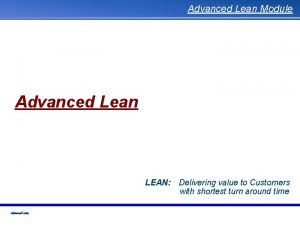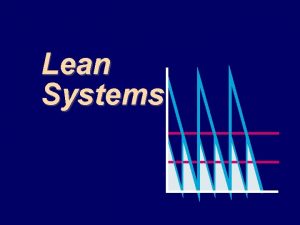Lean Systems Chapter 8 Copyright 2013 Pearson Education





















![Example 8. 1 b. Daily Demand [(1000+2200) pieces /week]/5 days = 640 pieces per Example 8. 1 b. Daily Demand [(1000+2200) pieces /week]/5 days = 640 pieces per](https://slidetodoc.com/presentation_image_h/c8438b45dfb48cf366e4893f02684408/image-22.jpg)




































- Slides: 58

Lean Systems Chapter 8 Copyright © 2013 Pearson Education, Inc. publishing as Prentice Hall 08 - 0

What is a Lean System? Lean Systems Operations systems that maximize the value added by each of a company’s activities by removing waste and delays from them. Copyright © 2013 Pearson Education, Inc. publishing as Prentice Hall 08 -02

Eight Types of Waste or Muda 1. Overproduction 5. Motion 2. Inappropriate Processing 6. Inventory 3. Waiting 7. Defects 4. Transportation 8. Underutilization of Employees Copyright © 2013 Pearson Education, Inc. publishing as Prentice Hall 08 - 03

Continuous Improvement Copyright © 2013 Pearson Education, Inc. publishing as Prentice Hall 08 -04

Supply Chain Considerations • Close Supplier Ties • Small Lot Sizes – Single-digit setup Copyright © 2013 Pearson Education, Inc. publishing as Prentice Hall 08 - 05

Process Considerations Pull Method of Workflow Customer demand activates the production of the service or item. Copyright © 2013 Pearson Education, Inc. publishing as Prentice Hall 08 - 06

Process Considerations • Quality at the Source – Jidoka – Poka-Yoke Copyright © 2013 Pearson Education, Inc. publishing as Prentice Hall 08 - 07

Process Considerations • Uniform Workstation Loads – Takt time – Heijunka • The leveling of production load by both volume and product mix. – Mixed-model assembly • Standardized Components and Work Methods Copyright © 2013 Pearson Education, Inc. publishing as Prentice Hall 08 - 08

Process Considerations • Flexible Workforce • Automation • 5 S • Total Preventative Maintenance Copyright © 2013 Pearson Education, Inc. publishing as Prentice Hall 08 - 09

5 S Copyright © 2013 Pearson Education, Inc. publishing as Prentice Hall 08 - 10

Toyota Production System • All work should be specified as to content, sequence, timing, and outcome. • All customer-supplier connections should be direct and unambiguous. • All pathways should be simple and direct. • All improvements should be made under the guidance of a teacher using the scientific method. Copyright © 2013 Pearson Education, Inc. publishing as Prentice Hall 08 - 11

House of Toyota Copyright © 2013 Pearson Education, Inc. publishing as Prentice Hall 08 - 12

One-Worker, Multiple Machines Copyright © 2013 Pearson Education, Inc. publishing as Prentice Hall 08 - 13

Group Technology Jumbled Flows without GT. Lines Flows with 3 GT cells Copyright © 2013 Pearson Education, Inc. publishing as Prentice Hall 08 - 14

What is a Value Stream Mapping? Value Stream Mapping A qualitative lean tool for eliminating waste or muda that involves a current state drawing, a future state drawing and an implementation plan. Copyright © 2013 Pearson Education, Inc. publishing as Prentice Hall 08 - 15

VSM Icons Copyright © 2013 Pearson Education, Inc. publishing as Prentice Hall 08 - 16

VSM Metrics • Takt Time – Cycle time needed to match the rate of production to the rate of sales or consumption. • Daily availability/Daily Demand • Cycle Time – The average time between completed units taking into account all resources available at a process step. • Processing Time – The time to complete one unit. Copyright © 2013 Pearson Education, Inc. publishing as Prentice Hall 08 - 17

Example 8. 1 • Jensen Bearings, Inc makes two types of retainers that are packaged and shipped in returnable trays with 60 retainers in each tray. The operations data is on the following slides. a. b. c. d. e. Create a VSM for Jensen Bearings What is the takt time? What is the lead time at each cell? What is the total processing time? What is the capacity? Copyright © 2013 Pearson Education, Inc. publishing as Prentice Hall 08 - 18

Example 8. 1 Copyright © 2013 Pearson Education, Inc. publishing as Prentice Hall 08 - 19

Example 8. 1 Copyright © 2013 Pearson Education, Inc. publishing as Prentice Hall 08 - 20

Example 8. 1 a. Copyright © 2013 Pearson Education, Inc. publishing as Prentice Hall 08 - 21
![Example 8 1 b Daily Demand 10002200 pieces week5 days 640 pieces per Example 8. 1 b. Daily Demand [(1000+2200) pieces /week]/5 days = 640 pieces per](https://slidetodoc.com/presentation_image_h/c8438b45dfb48cf366e4893f02684408/image-22.jpg)
Example 8. 1 b. Daily Demand [(1000+2200) pieces /week]/5 days = 640 pieces per day Daily Availability (7 hours/day) x (3600 seconds per hour) = 25, 200 seconds per day Takt Time = Daily availability/Daily Demand = 25, 200/640 = 39. 375 seconds per piece Copyright © 2013 Pearson Education, Inc. publishing as Prentice Hall 08 - 22

Example 8. 1 c. Production Lead time = Inventory/Daily Demand Raw Material Lead Time - 5 days WIP between Press and Pierce/Form = (2250/640) = 3. 5 days WIP between Pierce/Form and Finish/Grind = (3350/640) = 5. 2 days WIP between Finish/Grind and Shipping= (1475/640) = 2. 3 days Total Production Lead Time = (5 + 3. 5 + 5. 2 + 2. 3) = 16 days d. Total Processing Time = Sum of the Cycle Times (3 + 22 + 35) = 60 seconds Copyright © 2013 Pearson Education, Inc. publishing as Prentice Hall 08 - 23

Example 8. 1 e. Grinding is the bottleneck Capacity = 25200/37. 7 = 668 units/day Copyright © 2013 Pearson Education, Inc. publishing as Prentice Hall 08 - 24

Application 8. 1 • Gilman Inc. makes vending machines. The operations data is on the following slides. a. b. c. d. e. What is the cell’s current inventory level? What is the takt time? What is the lead time at each cell? What is the total processing time? What is the capacity? Copyright © 2013 Pearson Education, Inc. publishing as Prentice Hall 08 - 25

Application 8. 1 Overall Process Attributes Average demand: 200/day Batch size: 20 Number of shifts per day: 2 Availability: 8 hours per shift with a 45 minute break Customer One shipment of 1000 units each week Shipments Information All communications with the customer are Flow electronic There is a weekly order release to Cutting All material is pushed Copyright © 2013 Pearson Education, Inc. publishing as Prentice Hall 08 - 26

Application 8. 1 Processing Cut Step 1 Cycle time = 160 seconds Setup time = 3 minutes Up time = 100% Operators = 1 WIP = 600 units (Before Cut) Processing Grind Cycle time = 120 seconds Step 2 Setup time = 1 minute Up time = 99% Operators = 1 WIP = 800 units (Before Grind) Processing Bend Cycle time = 240 seconds Step 3 Setup time = none Up time = 100% Operators = 1 WIP = 400 units (Before Bend) WIP = 600 units (After Bend) Copyright © 2013 Pearson Education, Inc. publishing as Prentice Hall 08 - 27

Application 8. 1 a. Current Inventory Level (600 + 800 + 400 + 600) = 2400 units b. Daily Demand 200 units per day Daily Availability (8 hours/day * 60 min) – 45 seconds = 435 min x 2 shifts/day= 870 minutes per day Takt Time = Daily availability/Daily Demand = 870 /200 = 4. 35 minutes per unit Copyright © 2013 Pearson Education, Inc. publishing as Prentice Hall 08 - 28

Application 8. 1 c. Production Lead time = Inventory/Daily Demand Raw Material Lead Time - (600/200) = 3 days WIP between Cut and Grind = (800/200)= 4 days WIP between Grind and Bend = (400/200) = 2 days Finished Goods Lead Time after Bend = (600/200) = 3 days Total Production Lead Time = (3 + 4 + 2 + 3) = 12 days Copyright © 2013 Pearson Education, Inc. publishing as Prentice Hall 08 - 29

Application 8. 1 d. Total Processing Time = Sum of the Cycle Times (160 + 120 + 240) = 520 seconds e. Bending is the bottleneck Availability at Bending = 870 min/day Time at bottleneck = (240 + 0)/240 sec/unit = 4 min/unit Capacity = 870 / 4 = 217. 5 units/day Copyright © 2013 Pearson Education, Inc. publishing as Prentice Hall 08 - 30

What is a Kanban? Kanban A Japanese word meaning “card” or “visible record” that refers to cards used to control the flow of production through a factory Copyright © 2013 Pearson Education, Inc. publishing as Prentice Hall 08 - 31

The Kanban System Receiving post Kanban card for product 1 Kanban card for product 2 Storage area Empty containers Assembly line 1 O 2 O 1 Fabrication cell O 2 O 3 Assembly line 2 Full containers Copyright © 2013 Pearson Education, Inc. publishing as Prentice Hall 08 - 32

The Kanban System Receiving post Kanban card for product 1 Kanban card for product 2 Storage area Empty containers Assembly line 1 O 2 O 1 Fabrication cell O 2 O 3 Assembly line 2 Full containers Copyright © 2013 Pearson Education, Inc. publishing as Prentice Hall 08 - 33

The Kanban System Receiving post Kanban card for product 1 Kanban card for product 2 Storage area Empty containers Assembly line 1 O 2 O 1 Fabrication cell O 2 O 3 Assembly line 2 Full containers Copyright © 2013 Pearson Education, Inc. publishing as Prentice Hall 08 - 34

The Kanban System Receiving post Kanban card for product 1 Kanban card for product 2 Storage area Empty containers Assembly line 1 O 2 O 1 Fabrication cell O 2 O 3 Assembly line 2 Full containers Copyright © 2013 Pearson Education, Inc. publishing as Prentice Hall 08 - 35

The Kanban System Receiving post Kanban card for product 1 Kanban card for product 2 Storage area Empty containers Assembly line 1 O 2 O 1 Fabrication cell O 2 O 3 Assembly line 2 Full containers Copyright © 2013 Pearson Education, Inc. publishing as Prentice Hall 08 - 36

The Kanban System Receiving post Kanban card for product 1 Kanban card for product 2 Storage area Empty containers Assembly line 1 O 2 O 1 Fabrication cell O 2 O 3 Assembly line 2 Full containers Copyright © 2013 Pearson Education, Inc. publishing as Prentice Hall 08 - 37

The Kanban System Receiving post Kanban card for product 1 Storage area Kanban card for product 2 Empty containers Assembly line 1 O 2 O 1 Fabrication cell O 2 O 3 Assembly line 2 Full containers Copyright © 2013 Pearson Education, Inc. publishing as Prentice Hall 08 - 38

The Kanban System 1. Each container must have a card. 2. Assembly always withdraws from fabrication (pull system). 3. Containers cannot be moved without a kanban. 4. Containers should contain the same number of parts. 5. Only good parts are passed along. 6. Production should not exceed authorization. Copyright © 2013 Pearson Education, Inc. publishing as Prentice Hall 08 - 39

Number of Containers • Two determinations – Number of units to be held by each container – Number of containers – Little’s Law • Average work-in-process inventory equals the average demand rate multiplied by the average time a unit spends in the manufacturing process Copyright © 2013 Pearson Education, Inc. publishing as Prentice Hall 08 - 40

Number of Containers Work in Process (WIP) = (average demand rate) (average time a container spends in the manufacturing process)+ safety stock WIP = kc k = Copyright © 2013 Pearson Education, Inc. publishing as Prentice Hall 08 - 41

Example 8. 2 • The Westerville Auto Parts Company produces rocker-arm assemblies • A container of parts spends 0. 02 day in processing and 0. 08 day in materials handling and waiting • Daily demand for the part is 2, 000 units • Safety stock equivalent of 10 percent of inventory a. If each container contains 22 parts, how many containers should be authorized? b. Suppose that a proposal to revise the plant layout would cut materials handling and waiting time per container to 0. 06 day. How many containers would be needed? Copyright © 2013 Pearson Education, Inc. publishing as Prentice Hall 08 - 42

Example 8. 2 b. Figure 8. 10 from OM Explorer shows that with reduced waiting time, the number of containers drops to 8. 2, 000(0. 08 + 0. 02)(1. 10) k= 22 220 = = 10 containers 22 Copyright © 2013 Pearson Education, Inc. publishing as Prentice Hall 08 - 43

Application 8. 2 Item B 52 R has an average daily demand of 1000 units. The average waiting time per container of parts (which holds 100 units) is 0. 5 day. The processing time per container is 0. 1 day. If the policy variable is set at 10 percent, how many containers are required? k = = 1, 000(0. 5 + 0. 1)(1 + 0. 1) 100 = 6. 6, or 7 containers Copyright © 2013 Pearson Education, Inc. publishing as Prentice Hall 08 - 44

Other Kanban Signals • Container System – Using the container itself as a signal device. – Works well with containers specifically designed for parts. • Containerless System – Using visual means in lieu of containers as a signal device. – Examples: a painted square on a workbench = one unit. Copyright © 2013 Pearson Education, Inc. publishing as Prentice Hall 08 - 45

Organizational Considerations • The Human Costs of Lean Systems • Cooperation and Trust • Reward Systems and Labor Classification Copyright © 2013 Pearson Education, Inc. publishing as Prentice Hall 08 - 46

Process Considerations • Inventory and Scheduling – Schedule Stability – Setups – Purchasing and Logistics Copyright © 2013 Pearson Education, Inc. publishing as Prentice Hall 08 - 47

Solved Problem 1 • Metcalf, Inc makes brackets for two major automotive customers. The operations data is on the following slides. a. b. c. d. e. Create a VSM for Metcalf Bearnings What is the takt time? What is the lead time at each cell? What is the total processing time? What is the capacity? Copyright © 2013 Pearson Education, Inc. publishing as Prentice Hall 08 - 48

Solved Problem 1 Copyright © 2013 Pearson Education, Inc. publishing as Prentice Hall 08 - 49

Solved Problem 1 Copyright © 2013 Pearson Education, Inc. publishing as Prentice Hall 08 - 50

Solved Problem 1 Copyright © 2013 Pearson Education, Inc. publishing as Prentice Hall 08 - 51

Solved Problem 1 b. Daily Demand 2700 units per day Daily Availability (7. 5 hours/day) x (3600 seconds per hour) x (2 shifts/day)= 54, 000 seconds per day Takt Time = Daily availability/Daily Demand = 54, 000/2700 = 20 seconds per unit Copyright © 2013 Pearson Education, Inc. publishing as Prentice Hall 08 - 52

Solved Problem 1 c. Production Lead time = Inventory/Daily Demand Raw Material Lead Time - (4000/2700) = 1. 48 days WIP between Forming and Drilling = (5000/2700)= 1. 85 days WIP between Drilling and Grinding = (2000/2700) =. 74 day WIP between Grinding and Packaging= (1600/2700) =. 59 day Finished Goods Lead Time before Shipping = (15700/2700) = 5. 81 days Total Production Lead Time = (1. 48 + 1. 85 +. 74 +. 59 + 5. 81 days) = 10. 47 days Copyright © 2013 Pearson Education, Inc. publishing as Prentice Hall 08 - 53

Solved Problem 1 d. Total Processing Time = Sum of the Cycle Times (11 + 10 + 17 + 15) = 53 seconds e. Grinding is the bottleneck Capacity = 54000 / 17 = 3176 units/day Copyright © 2013 Pearson Education, Inc. publishing as Prentice Hall 08 - 54

Solved Problem 2 A company using a kanban system has an inefficient machine group. For example, the daily demand for part L 105 A is 3, 000 units. The average waiting time for a container of parts is 0. 8 day. The processing time for a container of L 105 A is 0. 2 day, and a container holds 270 units. Currently, 20 containers are used for this item. a. What is the value of the policy variable, α? b. What is the total planned inventory (work-in-process and finished goods) for item L 105 A? c. Suppose that the policy variable, α, was 0. How many containers would be needed now? What is the effect of the policy variable in this example? Copyright © 2013 Pearson Education, Inc. publishing as Prentice Hall 08 - 55

Solved Problem 2 a. We use the equation for the number of containers and then solve for α: k = 20 = 3, 000(0. 8 + 0. 2)(1 + α) 270 (1 + α) = 20(270) = 1. 8 3, 000(0. 8 + 0. 2) α = 1. 8 – 1 = 0. 8 Copyright © 2013 Pearson Education, Inc. publishing as Prentice Hall 08 - 56

Solved Problem 2 b. With 20 containers in the system and each container holding 270 units, the total planned inventory is 20(270) = 5, 400 units c. If α = 0 k= 3, 000(0. 8 + 0. 2)(1 + 0) 270 = 11. 11, or 12 containers Copyright © 2013 Pearson Education, Inc. publishing as Prentice Hall 08 - 57

All rights reserved. No part of this publication may be reproduced, stored in a retrieval system, or transmitted, in any form or by any means, electronic, mechanical, photocopying, recording, or otherwise, without the prior written permission of the publisher. Printed in the United States of America. Copyright © 2013 Pearson Education, Inc. publishing as Prentice Hall 08 - 58
 2013 pearson education inc
2013 pearson education inc 2013 pearson education inc
2013 pearson education inc Performance gap
Performance gap 2013 pearson education inc
2013 pearson education inc 2013 pearson education inc
2013 pearson education inc 2013 pearson education inc
2013 pearson education inc 2013 pearson education inc
2013 pearson education inc 2013 pearson education inc
2013 pearson education inc 2013 pearson education inc
2013 pearson education inc 2013 pearson education inc
2013 pearson education inc 2013 pearson education inc. answers
2013 pearson education inc. answers Employee testing and selection
Employee testing and selection 2013 pearson education inc
2013 pearson education inc 2013 pearson education inc
2013 pearson education inc Pearson education ltd
Pearson education ltd Copyright by pearson education inc. answers
Copyright by pearson education inc. answers 2010 pearson education inc
2010 pearson education inc Copyright 2009 pearson education inc
Copyright 2009 pearson education inc 2018 pearson education inc
2018 pearson education inc 2014 pearson education inc
2014 pearson education inc Copyright 2010 pearson education inc
Copyright 2010 pearson education inc Copyright 2010 pearson education inc
Copyright 2010 pearson education inc Copyright by pearson education inc. answers
Copyright by pearson education inc. answers 2008 pearson education inc
2008 pearson education inc Copyright 2009 pearson education inc
Copyright 2009 pearson education inc 2015 pearson education inc
2015 pearson education inc Copyright 2010 pearson education inc
Copyright 2010 pearson education inc Copyright 2010 pearson education inc
Copyright 2010 pearson education inc Copyright 2010 pearson education inc
Copyright 2010 pearson education inc Copyright 2010 pearson education inc
Copyright 2010 pearson education inc Copyright 2010 pearson education inc
Copyright 2010 pearson education inc Composition copyright example
Composition copyright example Pearson education inc all rights reserved
Pearson education inc all rights reserved Copyright 2009 pearson education inc
Copyright 2009 pearson education inc Copyright 2009 pearson education inc
Copyright 2009 pearson education inc Copyright 2009 pearson education inc
Copyright 2009 pearson education inc 2009 pearson education inc
2009 pearson education inc Copyright pearson education inc
Copyright pearson education inc Pearson education inc publishing as pearson prentice hall
Pearson education inc publishing as pearson prentice hall Pearson education inc publishing as pearson prentice hall
Pearson education inc publishing as pearson prentice hall Pearson education inc publishing as pearson prentice hall
Pearson education inc publishing as pearson prentice hall Pearson education inc. 2012
Pearson education inc. 2012 Copyright 2008
Copyright 2008 Copyright 2013
Copyright 2013 Copyright 2005 pearson prentice hall inc
Copyright 2005 pearson prentice hall inc Pearson vue ceo
Pearson vue ceo Stress management for life 5th edition
Stress management for life 5th edition Lean operations and systems
Lean operations and systems Lean systems operations management
Lean systems operations management Lean systems operations management
Lean systems operations management A production kanban authorizes a worker to:
A production kanban authorizes a worker to: Modina spirit
Modina spirit Lean systems operations management
Lean systems operations management Pakistan education statistics 2013
Pakistan education statistics 2013 Enhanced basic education act of 2013
Enhanced basic education act of 2013 Pearson education
Pearson education 2004 pearson education benjamin cummings
2004 pearson education benjamin cummings Pearson education limited 2008
Pearson education limited 2008 Carbon cycle pearson education
Carbon cycle pearson education


